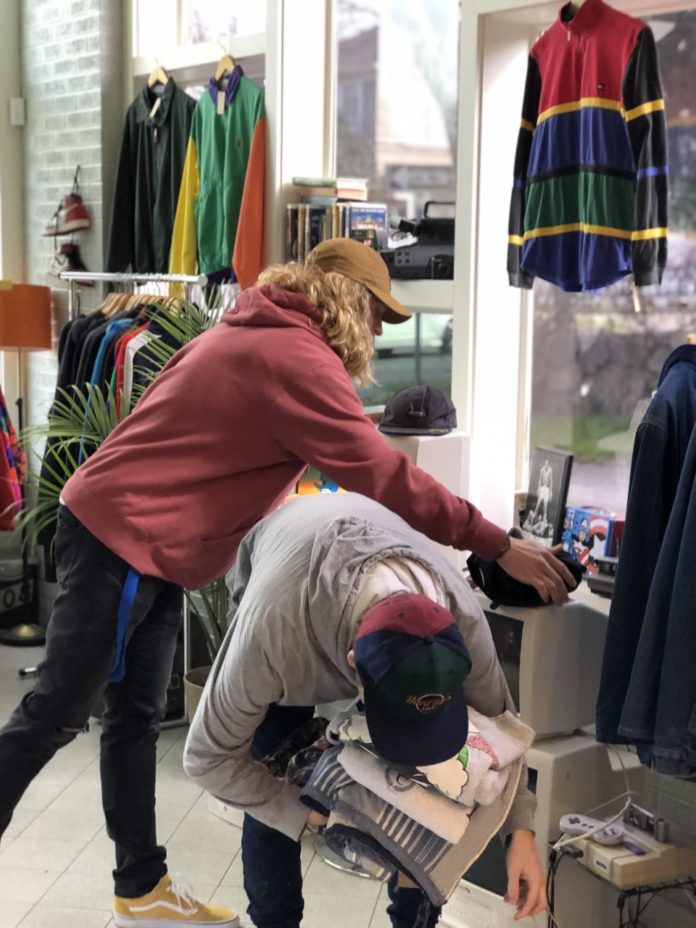
By Claire Van Zee | Reporter
With the topic of climate change being at the forefront of today’s concerns, it’s no surprise that people are beginning to take a step back to rethink the way they consume.
One of these ways being how they participate in the fashion industry, which is often criticized for its incredibly large carbon footprint.
While there are many sectors in the field of fashion, there is one sector that remains considerably wholesome in terms of its effect on the environment: thrift and vintage shopping.
Thrift or vintage shopping actually falls under the category of sustainable fashion. The term, while not new, continues to be something that is hard to define, even by those who know it best, such as Baylor’s own apparel studies professor, Andie Day.
Day, who owns her own apparel company Mary Claret, explains it’s difficult to understand because everyone has a different idea of what sustainability means, especially those working in the fashion industry.
“Sustainability is dependent on the individual’s idea of what matters when it comes to the ethics of a business,” Day said. Does the use of animals matter to them? Are they concerned about fossil fuel usage, in terms of how materials are transported?
“We tend to think of a sustainable business as a business that can last and have longevity but tied to ethics, that there is a sort of ‘do-no-harm’ approach to producing fashion,” Day said.
But when a company says they produce “sustainable fashion,” they are not being totally transparent. There is no one way to produce new products that are 100% sustainable.
Ultimately, companies are always producing and consuming, meaning they are always using valuable resources. To make a business, the process is partially not sustainable, but it’s also important to note that they are producing something that people need, Day said.
“There are a million different ways that one can look at sustainability, and different businesses are approaching it different ways in order to produce products that they believe are in some way sustainable,” Day said.
Jordan Wilkins, a sophomore apparel design student from McAllen, created a product that just happens to be both sustainable and functional, with her design of a sweatshirt with an interchangeable hood and sleeves.
Because of the way the sweatshirt is made, it has a higher number of wears than the average hoodie.
“I think sustainability is also about how well a garment is made, because if you can’t wear it more than maybe 10 to 15 times, then how useful is that garment to you?” Wilkins said.
Oftentimes, by the time someone is done with a piece of clothing, the item itself still has a number of wearable years left. The unique quality of vintage and thrift shopping is that together, they just happen to be one of the purest sectors of the fashion industry. Instead of throwing an item away and it living out the rest of its years in a landfill, people donate or sell the clothing to a retailer.
While vintage and thrift shopping are similar in their environmental benefits, there is a particular difference between them.
“Every year that goes by, vintage goes up in its date. For example, whereas at one point we would have considered clothing from the ‘40s, ‘50s and ‘60s to be vintage, we are now considering the ‘80s to be vintage,” Day said.
Vintage shopping is associated with a particular time period, whereas thrifting would just be the reselling of used products.
“What’s interesting with the vintage, thrifting or used clothing movement is that it has been really hard to make a vintage business big enough that it’s not just a single store or website,” Day said.
Companies such as The Real Real and Reformation are the exception, and are hopefully on their way to setting the rule. The Real Real is a luxury consignment company that has ambassadors around the world consigning products to sell online.
According to its website, “Consignment softens luxury’s impact on the environment, and we can prove it.”
In effort to solidify its standing as an environmentally concerned company, it developed a first-of-its kind sustainability calculator to quantify its positive environmental impact. Their results conclude that since the company’s inception, they have saved 553 million liters of water and offset 12,200 metric tons of carbon. Their custom calculator also measures the greenhouse gasses, energy output and water usage offset by the consignment process.
In 2015 alone, the fashion industry consumed 79 billion cubic meters of water, enough to fill nearly 32 million Olympic-size swimming pools, according to a 2017 report by the Global Fashion Agenda and The Boston Consulting Group. By 2030, the statistic is expected to increase by 50 percent and reach a number far above the already overwhelming amount.
While not every student can afford to shop for consigned luxury items, there are different ways in which students can be more environmentally conscious while shopping.
Day recommends students simply become more knowledgeable and interested in the companies they do choose to shop from.
“In this way, when people want to learn more about the companies, the more important transparency becomes in the way companies share their sustainable practices and ethics,” Day said.





